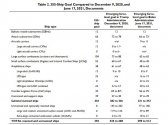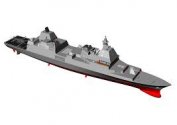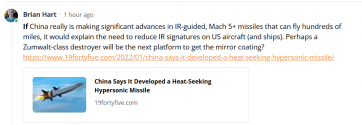It has no technology that will not have been tested on previous ships. The radars will be from the DDG-51 FIII family of GaN radars. Electric propulsion tested on the Zumwalt and the frigate Constellation. It is a natural evolution of the future great combatants of the US Navy.
In the NAVSEA file it says that 32 silos can be exchanged for 12 larger silos to fit the hypersonic missiles, it doesn't say there are 32 cells ahead. For now there is a lot of speculation about the total number of silos. The US Navy has already said it wants at least the same 96 silos as the Arleigh Burkes.
One possibility is that the forward silo group may have 64 silos and the midship group
among the chimneys, another 64, totaling 128 silos, the same number as a “Ticonderoga” that, due to 2 built-in cranes for remunication on the high seas, resulted in the loss of 6 silos.
.
All that you say doesn't make any sense when analyzing the ship's displacement and the total combat capability of the DD(X). Everything indicates that it will displace more than a “Ticonderoga” and “Arleigh Burke III”, both in the range of 9600 tons loaded, however, less than a “Zumwalt” of about 15,000 loaded, it is speculated something in the range of 12,000 to 13,000 tons loaded. The future DDG, if it actually follows the specifications presented, will have a displacement of about 13,000 tons also due to the greater inclusion of steel in the construction, but, there will not be a significant increase in armament, the number of silos should be between 96 and 128 and a second main cannon will be exchanged for other guns and stuff like that.
I have given you two specific examples of newer ship designs, the Zumwalt with its 70 cells, and the MKS 180, with its 64 cells despite having 11,000 tons, that navies are no longer hamming as much VLS cells into their ships, likely in exchange for more livable space within the ship. The stress sailors live within the cramped confines of a ship in several months of extended deployment is real. Note that the Constellation class, which is nearly the size of a 052D, only has 32 cells VLS, and there are anecdotal reports that the 052D isn't the most comfortable ship to live for extended periods either.
The increase of space within the future DDG isn't just due for the needed increase of living space, but also for the cooling of the electronics. You point out the SPY-6 on the Flight III, however, the text shows a potentially larger SPY-6 with up to 57 RMAs, up from the 37 RMAs on the Flight III. Considering that a considerable amount of the displacement and weight gain on the Flight III is due to the needed cooling for these radars, I am going to assume that the a larger SPY-6 would have even greater cooling requirements.
Then you have the IEPS system. This isn't exactly the most space efficient of propulsion. You are going to need large electric motors and even backup battery supply. Considering that you are planning to have lasers, and that along with the larger variant of the SPY-6, you are looking towards larger generators.
At the same time you also want larger hangers for helicopters, greater range endurance which means a larger fuel capacity, and on and on.



